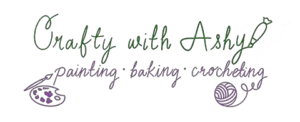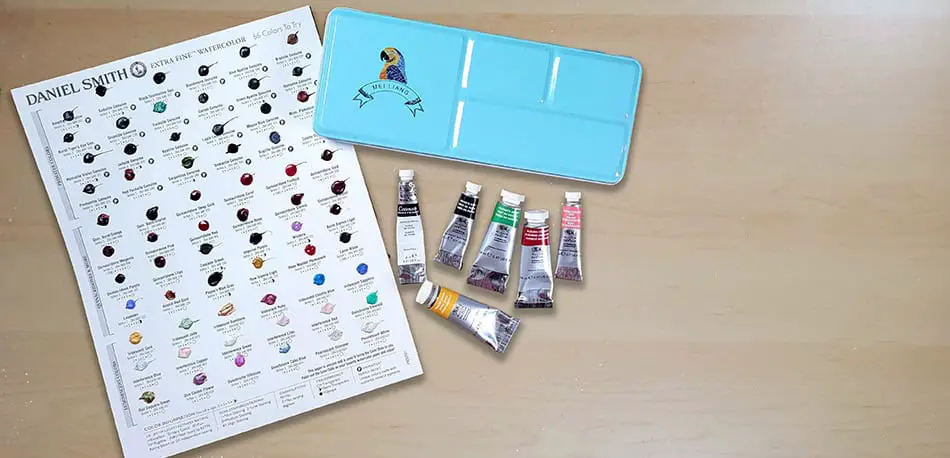There are at least 30 brands of professional-grade and countless more student-grade watercolor paint available. So how do you choose?
I recommend professional-grade watercolor paint due to the pigment load and ease of activating the paint. The two brands I recommend specifically are Daniel Smith and Winsor & Newton. Both offer a wide range of colors and are of exceptional quality.
Let me tell you more about each option and why I recommend them.
Daniel Smith Extra Fine Watercolor
Daniel Smith’s watercolors have been world-renowned since 1993 when their first watercolors were released. The fact that a company this young is so well-known and highly regarded speaks to the excellence of their product.
The watercolors are incredibly high quality and offer the most extensive color range, currently more than 260, of all the professional watercolor brands. The paints are highly pigmented with excellent tinting strength and lightfastness.
The tube paints are consistently well mixed and do not dry out in the tubes. When squeezed into pans, shrinking is more evident than with some other brands, and it is recommended to pour in stages. The paints reactivate quickly and easily after drying, making achieving a thick, buttery consistency easy.
If you are interested in trialing Daniel Smith watercolor paints, purchase a super affordable 66-color dot card so you can swatch and make small paintings to trial the line. The dot card provides information on each color’s lightfastness, staining, transparency, and granulation.
Winsor & Newton Professional Watercolor
Introduced in 1832, Winsor & Newton Professional Watercolors have historically been the gold standard of watercolor paints. They are among the most highly recommended watercolor paint brands, and I understand why!
They offer over 100 colors in the professional line, giving a wide range of hues and personalities. They are formulated to have excellent transparency and permanence, so the colors stay vibrant layer after layer. They also provide the luminosity that high-quality watercolor is known for. With most colors having a high permanence rating, your artwork will not fade over time (with proper care.)
The tubes are high quality and prevent the paint from drying out for years! The paint is well mixed and does not tend to separate in the tube. When squeezed into pans, it cures nicely and, with few exceptions, does not shrink and crack. The paint reactivates easily with minimal time or effort required.
Winsor & Newton offers a dot card that includes all 109 colors from their professional range. It comes on watercolor paper with nice-sized squares for swatching. It lists the permanence, opacity, and lightfastness ratings for color. It also has a St or a G for staining or granulating.
The dot card offers enough paint to create the swatches, but it wouldn’t stretch to do a full painting. It is relatively inexpensive for the number of colors. It is definitely a good investment if you plan to build your own palette but want to test the colors before buying a whole tube!
Best Beginner Watercolor Set
As a beginner, I highly recommend starting with a limited palette. This will decrease the initial cost of your new hobby and encourage you to learn about color mixing.
Daniel Smith offers the perfect tube set called the “Watercolor Essentials Set.” The colors are chosen based on the split primary color theory, which breaks each primary color (red, blue, and yellow) into its warm and cool versions.
Split primary palettes offer greater mixing capacity than the traditional primary color wheel, which has only three colors. You can mix vivid or muted secondaries (greens, oranges, and purples). You can also mix fantastic neutrals like greys and browns from this set’s limited palette.
The range of mixing capacity is ideal for painting all subject matters! With the range of colors you can mix, portraits, landscapes, florals, and architecture are all viable subject options.

Best Budget Watercolor Set
Winsor & Newton Cotman is a very high-quality student-grade watercolor paint. It is an excellent option for those on a tighter budget, as it is significantly cheaper than their professional line. It will offer a great experience and does not dry chalky like many low-quality watercolor paints.
It takes longer to activate and has a lower pigment load than Winsor & Newton Professional. This means that you should spray down the paints with a generous amount of water and wait a minute before using them, and you need to use a bit more of the paint to get the same color intensity.
Though it takes a little more time to activate, once it is awake, it will behave well for all the watercolor techniques, including wet on wet, wet on dry, dry brushes, etc.
These paints offer high lightfastness and are pigment-based (versus dye-based, like some more budget options.) This means that your artwork is less likely to fade if exposed to sun/UV light. It also means that these watercolor paints tend to stain less, which is generally a benefit for watercolorists, especially those who like to use the lifting technique.
Many Cotman half-pan sets are available, but I recommend the Winsor & Newton Cotman Watercolor Field Set. It contains limited colors, including the split primary options, to allow for an excellent mixing range.
Budget Watercolor Paint Set with Color Variety
As a budget alternative to other watercolor paint options, many pan watercolor sets offer a pleasant painting experience, especially for beginners. These often have a large variety of colors for those who don’t want to start out learning color mixing and would prefer to have many convenience colors.
MeiLiang offers a 36 color set which has a huge variety of colors. The paints are very vivid and dry to a nice finish, though minimally chalky compared with professional brand watercolors.
These paints activate very quickly with just a swipe of a wet paintbrush. The colors perform well with wet on dry, wet on wet, or dry brush techniques, making them fantastic for beginners wanting to learn all the watercolor techniques. There are various transparency levels, which can be fun to play around with. In other words, this paint will not be a barrier to your learning of watercolor painting.
The colors tend to be more staining and less lightfast than professional grade paints. This is likely due to dye fillers or brighteners in the paints (versus being more pigment based). I don’t know all the science behind this, but it is something to be aware of if you plan to do a lot of the lifting technique or if you plan to display your artwork in highly lit areas for any period of time.
I hope you learned something about watercolor paint options. If you have any questions or any other recommendations, drop them in the comments! I’d love to hear from you!

